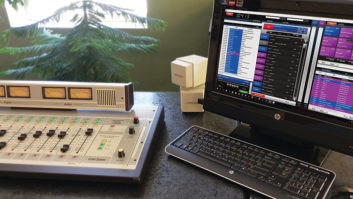The following interview appeared in the recent Radio World eBook “AM Translators: What’s Next?”

Timothy L. Warner, P.E., has put translators on the air since 1987, first as a public radio manager and then a full-time consultant, doing applications, specifying antennas and managing site builds.
Radio World: What advice would you offer to an AM radio manager who may have the opportunity to build a translator thanks to the recent windows?
Timothy Warner: First let’s consider AM stations with window applications.
What has been filed so far is only a short-form “expression of interest.” The next step will be either resolution of a mutual exclusivity or a long-form complete application.
By now you should have restudied your application to see if there are others with which you may conflict. If there are conflicts, work with your engineer and attorney on options. Look around for additional useful FM broadcast sites, which are not always the same as good AM sites. If you have a singleton, realize that it is still a short-form, and you can possibly improve it at the long-form stage.
Don’t worry about the equipment until much later in the project. When you do start looking at equipment, FM has several differences from AM. You need to process the audio differently. A side-mounted FM antenna is never completely omnidirectional, so discuss mounting in detail with antenna manufacturers or providers.
For Class C and D AM stations without applications: Some who were eligible did not file in the recent window. In some cases, they already have a translator and are satisfied. In other cases, perhaps the benefits did not seem to be worth the costs. In some cases, there are no useful frequencies. For those with existing translators, the recent change to allow translators in the greater of 25 miles or the 2 mV/m provides an opportunity to extend beyond the coverage area of a single translator.
Or, the new translator (which will be permanently bound to the AM station) can substitute for the existing translator, which can then be sold, perhaps to an FM station with an HD2 service that they want to put into analog form. I was able to find two cases where the new translator, through a minor modification, can return to the existing frequency when the new one is sold and moved to a new site.
AM stations with no applications or moves should know that AMs of any class, if they have not taken advantage of the “250-Mile Move Window” or the first new translator window, will be able to apply in the next window, yet to be scheduled.

Timothy L. Warner
RW: How is putting a translator on the air different from building a station from the start?
Warner: Translators do not require new studios or new program streams. They provide additional distribution for existing programming. They require additional marketing, so that people can find them, but they make use of already existing programming. You do need to pay attention to the differences between AM and FM, though. Do you want to be in stereo? How will your signal sound with improved frequency response and signal to noise ratio?
RW: What kinds of questions should a manager have ready to talk intelligently about a project?
Warner: What area are you trying to serve? This is critical. Translators are power-limited, so putting the signal where you can use it is important. If your listeners, and your target listeners, are in a particular direction from the AM site, that is important. Because the FM band is already pretty full, the frequency you choose to serve in one direction may be different from the frequency you would choose to serve in another direction. If you have two or three areas that are at the fringe of the AM signal, you probably need to choose which to emphasize. For AM stations with an existing translator, look at both to see how you can optimize total coverage.
Are there areas that are not important? If you consider yourself local to a specific area, and that is your programming advantage, where are you willing to sacrifice? If you broadcast sports for one school system but consider another system the opponents, that can be important.
Do you have existing relationships with other broadcasters in the area, particularly any with tall towers? AM translators are limited in power, but not necessarily in height. Do you have any connections with other desirable sites — mountaintops, for instance?
When it comes time to talk equipment, look at the different options before deciding on a single path. Sometimes a single-bay antenna is all that a tower can hold, and you will need a more powerful transmitter. Sometimes a second- or third-adjacent channel protection will require a very specific multi-bay antenna, and the transmitter will be much smaller. Allocations issues many times restrict your choices.
RW: Now that the translator movement has taken hold, are AM broadcasters finding success with it financially?
Warner: AM stations are finding new listeners, and in many cases increased listener satisfaction. Making it pay is a little slower. Stations need to educate their advertisers in advance, particularly stations whose nighttime coverage has been limited. For instance, if your Friday night football now covers the whole town, both potential new listeners and advertisers need to be brought on board.
For those AM stations who have marketed the improvement, the translators are paying off.
RW: You told me that some people do not fully appreciate limits to translator allocations — that it’s possible to build a translator or LPFM that meets allocation requirements but suffers from so much incoming interference that it is worthless. How can a planner avoid this problem?
Warner: First, have your technical consultant study the incoming interference, co-channel and adjacent channel. Pay attention to whether close in signals on first- or second-adjacent channels are broadcasting in hybrid HD mode. Second-adjacent with HD acts more like first-adjacent near the HD transmitter site. Digital interference into analog sounds different, but still can cause significant reception problems.
Then drive the area and listen. Get a list of possible frequencies, as early in the process as you can, and listen to any frequency that might work. It takes some time to become familiar with your radio, to be able to distinguish between really quiet channels and those with too much interference for a translator to overcome.
The biggest value of listening is in identifying stations where terrain or other factors distort coverage, which can be good or bad. FM coverage contours are based on terrain from 3 to 16 kilometers (2 to 10 miles) from the transmitter site. I know of stations where the official Height Above Average Terrain is one number, but in some directions, the effective height is triple that number. Conversely, sometimes a mountain ridge can block a station that looks like it would be a problem.
Translators are a secondary service. If a translator causes interference to regular listening to a full-service station or a previously authorized translator or LPFM station, the translator must correct the interference or go off the air. The FCC has issued several decisions, making it clear that the listening must be real, and not station personnel or relatives. The translator must be offered the opportunity to observe and try to correct the interference. You don’t want to go to the expense and effort of building a translator, only to turn it off. In the current windows, you can only do minor modifications to solve a problem.
There are several proposals before the FCC that would change some of the requirements for interference complaints or increase flexibility in changing channels, but those are not to the status of proposed rules yet.
RW: What’s the most interesting experience you’ve had with a translator project?
Warner: I helped one client put on a translator, where the allocation was clear. However, there was an old-line station in a neighboring market, with program hosts who had loyal followings for over 30 years. People had moved to my client’s area but still listened to the distant signal. The personal connection to the old home town was strong enough that people listened through the noise. We turned the translator off, and found another frequency.
Early on, I was involved with a translator that looked good, but in reality there was too much incoming signal from a distant station. The terrain was perfectly against it. I suspect that the antenna for the distant station was optimized in the direction of the translator, but there was no way to fix coverage on that frequency.
On the plus side, one of my AM clients has changed all the marketing materials to show the call letters of the AM station but only the FM frequency. That translator is 1,000 feet above average terrain, with great coverage.
RW: What else should we know?
Warner: Most of the available translator frequencies now require waivers of interference to second- or third-adjacent stations. When done properly, the possibility of interference is quite small. The procedures are well studied. Often, to get a waiver, you will need to use a very specific antenna, with multiple bays and sometimes non-standard bay-to-bay spacing. The antenna expense goes up, but the specific antennas are necessary.
It seems counterintuitive, but you can use a simpler antenna if you move toward the second- or third-adjacent station. Where their signal is stronger, they can tolerate more translator signal without real interference. If you must use the AM site, you may pay a penalty in antenna cost.
Figs. 1 and 2, described in the text, show a translator application in a problem setting. Warner said this allocation meets FCC requirements but would cause significant interference to the full-power station while providing only a small clean service area.
Click to Enlarge


Many translators are also directional. There are some off-the-shelf directional antennas that can be quite useful. Often, you can cover the most area with a custom directional antenna. Many of the major manufacturers can directionalize their low-power antennas, but some cannot. Check before you specify in your construction permit application, because you must use the antenna you specify, or you will need to file a modification.
RW: Are there visuals you can suggest to illustrate this topic?
Warner: I prepared a couple of maps (Figs. 1 and 2) showing a translator application in a problem setting. Contours show that the translator 40 dBu interference contour is well clear of the full-power station 60 dBu service contour, but a Longley-Rice propagation showing reveals that there is 60 dBu signal around and beyond the translator site. The second map shows signal ratios. The area where interference is predicted, that is, the signals are within 20 dB of each other, is very large. The area where the translator would have a predicted clean signal is small and spotty. The allocation meets FCC requirements, but would cause significant interference to the full-power station, while having a very small clean service area. (Some car radios can survive ratios lower than 20 dB, but that does not get around the full-power station service area near the translator site. The full-power station has reported listening in the ZIP code where the translator is proposed.)
Fig. 3. With increased HAAT and a directional antenna, population served by this translator almost tripled.
Click to Enlarge

I worked with an AM station with an existing translator on the AM tower, 190 feet above ground (Fig. 3). They were able to get space on a TV tower on higher ground. It meant using a directional antenna. With the antenna 300 feet above ground, the Height Above Average Terrain increased from 193 feet to 875 feet overall, and more than 1,000 feet HAAT over the community of license. Population nearly tripled. The signal reports are even better than the map shows.












